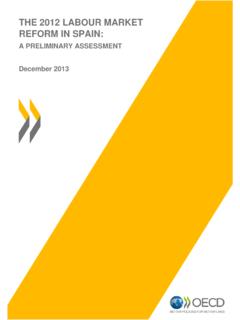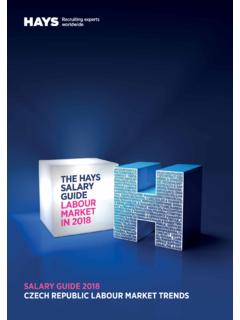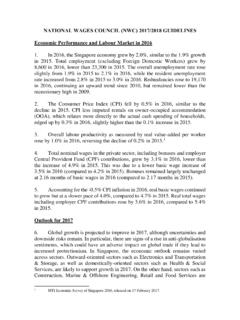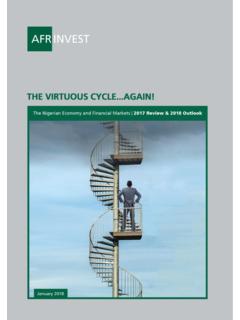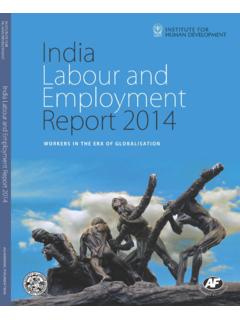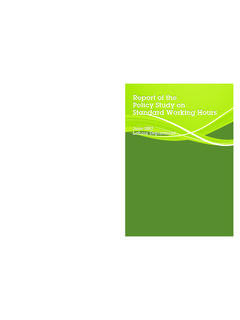Transcription of LABOUR MARKET FLEXIBILITY Axe1 Mittelstadt - OECD.org
1 LABOUR MARKET FLEXIBILITY Friedrich Klau and axe1 Mittelstadt CONTENT Introduction .. I . LABOUR MARKET FLEXIBILITY and efficiency .. II . Criteria and determinants of LABOUR MARKET FLEXIBILITY .. A . Aggregate real LABOUR cost FLEXIBILITY .. B . Adaptability of relative LABOUR costs across enterprises and occupations .. C . LABOUR mobility .. D . FLEXIBILITY of working time and work schedules .. 111 . Indicators of LABOUR MARKET FLEXIBILITY .. A . Indicators of aggregate LABOUR cost FLEXIBILITY .. 1 . Measures derived from aggregate wage equations .. 2 . Other indicators .. 3 . Possible changes in wage FLEXIBILITY .. B . Indicators of adaptability of cost differentials.
2 C . Indicators of LABOUR mobility .. D . Indicators of FLEXIBILITY of working time and work schedules .. E . Major results .. Bibliography ..8 8 10 10 12 13 14 14 14 15 19 22 27 35 37 40 44 The authors are members of the Growth Studies Division of the OECD Economics and Statistics Department . They gratefully acknowledge helpful comments by D . Coe. A . Dean. G . Holtham and M . Yoshitomi . 7 INTRODUCTION Recent and projected LABOUR MARKET trends are characterised by increasing polarisation and segmentation among OECD countries and within national LABOUR markets. European unemployment is forecast to exceed the North American rate by large margins with high unemployment countries likely to see continued increases and countries with comparatively low levels of unemployment further declines.
3 At the same time, long-duration unemployment and the excess of youth over total unemployment rates are typically most serious in high-unemployment countries. It is often argued that differences between unemployment rates for countries or regions are in part explicable in terms of different degrees of LABOUR MARKET "rigidity" - or to put it positively, " FLEXIBILITY ". Price shocks arising in conditions of "rigid" LABOUR markets are thought to lead to higher structural unemployment, while "flexible" LABOUR markets allow adjustments to such shocks with no or little employment loss. Making LABOUR markets more responsive to changing demand and supply conditions, if that were possible, would therefore help to remove impediments to a return to sustainable high employment levels.
4 The purpose of the present paper is to examine these propositions and to consider their implications for policy. Part I considers desirable degrees of LABOUR MARKET FLEXIBILITY in the light of demand and supply shocks. Part ll discusses different aspects of LABOUR MARKET FLEXIBILITY . Part 111 presents a number of indicators relating to the functioning of LABOUR markets. Special attention is devoted to implications which different degrees of LABOUR MARKET FLEXIBILITY may have for employment in the event of external price shocks. I. LABOUR MARKET FLEXIBILITY AND EFFICIENCY Contract theory of LABOUR markets suggests that the smoothing of income over time is a natural feature of LABOUR markets in industrialised countries.
5 Turnover costs of hirings, quits and lay-offs are usually high, especially for skilled workers with firm-specific human capital. Moreover, perceptions of fairness and justice largely based on historical relationships strongly affect work motivation and hence 8 productivity. There is a permanent risk of losses in "team" or firm productivity flowing from a decline in work motivation of individuals or a small group of employees. Hence, from the point of view of employers, income smoothing is desirable so long as demand variations remain within the expected range and are perceived as being temporary. For employees, stable wage incomes over the contract period are preferable to volatile income flows since consumption expenditure is more easily planned under conditions of predictable wages than in the presence of potentially large income losses.
6 For these reasons, employers and employees enter into long-term work relationships (cf. Schultze, 1 984, Hall, 1980 and Nissim, 1984). Under long-term work arrangements, which add to job security, employees may receive a wage in excess of their marginal revenue product in the early part of the employment period. With human capital accumulating, this pattern is often reversed with time, with wages and fringe benefits eventually tending to equate the marginal LABOUR product over the entire contract period. Given the mutual benefits from longer-term work relationships, some measure of wage inertia may be viewed as an indispensable element of LABOUR MARKET efficiency.
7 Similarly, search unemployment, a normal feature of LABOUR markets, is essential to LABOUR MARKET efficiency as it assists the optimal allocation of LABOUR resources. Long-term work attachments tend to impart a rigid bias to money wages over the business cycle in that the behaviour of money wages differs from what would be observable in "auction" LABOUR markets. Long-term work attachments also imply that relative wage positions remain broadly stable over the cycle. In contrast, differentials between wages for skilled and unskilled wages tend to widen in a downswing and narrow in an upswing reflecting the greater cyclical sensitivity of wages at the lower end of the wage spectrum.
8 The optimal degree of LABOUR MARKET FLEXIBILITY (consistent with LABOUR MARKET efficiency) changes when unexpected demand or supply shocks occur, upsetting the framework of expectations incorporated into long-term work arrangements ("climate change"). Shocks like those experienced in the 1970s require more than temporary changes in economic relationships since they may entail Ionger-lasting reductions in productivity growth, and enhance uncertainties and risk aversion. In such a situation, employers may no longer find it profitable or feasible to fulfil previously established wage contracts and related aspirations. In contrast, employees operating within the old framework of wage determination may initially resist changes in contractual relationships, making LABOUR markets inflexible in the wake of shocks.
9 Much of the recent discussion about the need for greater LABOUR MARKET FLEXIBILITY is therefore about macro and micro "climate changes" in economic 9 conditions and their short- and longer-run impact on output and inflation. The crucial question is how much time it takes to "..break through the short-run stickiness of wages and prices in the face of relative disturbances to produce the aggregate ". (Schultze, 1984). II. CRITERIA AND DETERMINANTS OF LABOUR MARKET FLEXlBlLlTY The present study distinguishes four broad aspects of LABOUR MARKET FLEXIBILITY : i) ii) iii) LABOUR mobility; iv) Real LABOUR cost FLEXIBILITY at the economy-wide levei; Adaptability of relative LABOUR costs across occupations and enter- prises; FLEXIBILITY of working time and work schedules.
10 The first two are macro- and microeconomic aspects of LABOUR -cost FLEXIBILITY , while the latter two relate to the quantitative and qualitative adaptability of the supply and the use of LABOUR . Some of these elements interact. For example, rigid wages for full-time employment may lead to increased openings for part-time work raising the FLEXIBILITY of working time and work schedules. Similarly, MARKET -clearing wage differentials partly depend upon the degree of LABOUR mobility. A. Aggregate real LABOUR cost FLEXIBILITY Aggregate real LABOUR cost FLEXIBILITY is a macroeconomic concept. Perfect FLEXIBILITY of real LABOUR costs would require immediate and full adjustments of real-product wages and related non-wage LABOUR costs to changing productivity levels or terms of trade.










